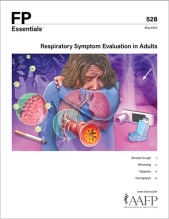
This clinical content conforms to AAFP criteria for CME.
Dyspnea is a common presenting symptom that may derive from pulmonary or extrapulmonary origins. Dyspnea may develop from exposure to drugs or environmental and occupational factors, so a thorough history and physical examination may help differentiate the cause. Chest x-ray followed by chest computed tomography scan if needed is recommended as the initial imaging test for pulmonary-related dyspnea. Nonpharmacotherapy options include supplemental oxygen, self-management with breathing exercises, and airway interventions with rapid sequence intubation in emergency situations. Pharmacotherapy options include opioids, benzodiazepines, corticosteroids, and bronchodilators. After the diagnosis is identified, treatment focuses on optimizing dyspnea symptoms. Prognosis depends on the underlying condition.
Case 3. BH is a 56-year-old patient who comes to your office reporting shortness of breath for “a while” and that has worsened in the past 6 months. He reports that dyspnea on exertion improves with rest. He reports no lower extremity edema or orthopnea. He reports no history of smoking or drug use. BH works in an auto body repair shop, where he spends a lot of time around auto paint. He also travels to visit family in Mexico regularly. Vital signs are essentially normal, with an oxygen saturation of 98% on room air and a body mass index of 28 kg/m2. He is requesting a refill on an albuterol inhaler he obtained from another physician for a reported diagnosis of asthma. BH reports that he uses the albuterol inhaler 4 to 5 times/day, and it seems to be helping him breathe better. However, he feels so tired most of the day that it affects his ability to do his job. He wants to know what can be done to help with his symptoms and the fatigue.
Subscribe
From $350- Immediate, unlimited access to FP Essentials content
- 60 CME credits/year
- AAFP app access
- Print delivery available
Edition Access
$44- Immediate, unlimited access to this edition's content
- 5 CME credits
- AAFP app access
- Print delivery available
